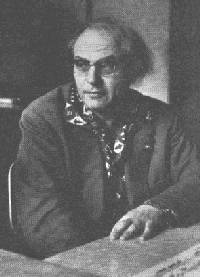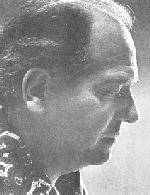Olivier Messiaen (1908-1992)
 (born
Avignon, 10 December 1908; died Paris, 27 April 1992).
(born
Avignon, 10 December 1908; died Paris, 27 April 1992).
He studied at the Paris Conservatoire (1919-30) with Dukas, Emmanuel
and Dupré, and taught there (1941-78) while also serving as organist
of La Trinité in Paris. Right from his first published work, the
eight Preludes for piano (1929), he was using his own modal system, with
its strong flavouring of tritones, diminished 7ths and augmented triads.
During the 1930s he added a taste for rhythmic irregularity and for the
rapid changing of intense colours, in both orchestral and organ works.
Most of his compositions were explicitly religious and divided between
characteristic styles of extremely slow meditation, bounding dance and
the objective unfolding of arithmetical systems. They include the orchestral
L'ascension
(1933), the organ cycles La nativité du Seigneur (1935) and
Les corps glorieux (1939), the song cycles Poèmes pour
Mi (1936) and Chants de terre et de ciel (1938), and the culminating
work of this period, the Quatuor pour la fin du temps for clarinet,
violin, cello and piano (1941).
During the war he found himself surrounded by an eager group of students,
including Boulez and Yvonne Loriod, who eventually became his second wife.
For her pianistic brilliance he conceived the Visions de l'amen
(1943, with a second piano part for himself) and the Vingt regards sur
l'enfant Jésus (1944), followed by an exuberant triptych on
the theme of erotic love: the song cycle Harawi (1945), the Turangalîla
-symphonie with solo piano and ondes martenot (1948) and the Cinq
rechants for small chorus (1949). Meanwhile the serial adventures of
Boulez and others were also making a mark, and Messiaen produced his most
abstract, atonal and irregular music in the Quatre études de
rythme for piano (1949) and the Livre d'orgue (1951).

His next works were based largely on his own adaptations of birdsongs:
they include Réveil des oiseaux for piano and orchestra (1953),
Oiseaux
exotiques for piano, wind and percussion (1956), the immense
Catalogue
d'oiseaux for solo piano (1958) and the orchestral Chronochromie
(1960). In these, and in his Japanese postcards Sept haïkaï
for piano and small orchestra (1962), he continued to follow his junior
contemporaries, but then returned to religious subjects in works that bring
together all aspects of his music. These include another small-scale piano
concerto, Couleurs de la cité céleste (1963), and
the monumental Et exspecto resurrectionem mortuorum for wind and
percussion (1964). Thereafter he devoted himself to a sequence of works
on the largest scale: the choral-orchestral La Transfiguration (1969),
the organ volumes Méditations sur le mystère de la Sainte
Trinité (1969), the 12-movement piano concerto Des canyons
aux étoiles... (1974) and the opera Saint François
d'Assise (1983).

 (born
Avignon, 10 December 1908; died Paris, 27 April 1992).
(born
Avignon, 10 December 1908; died Paris, 27 April 1992).